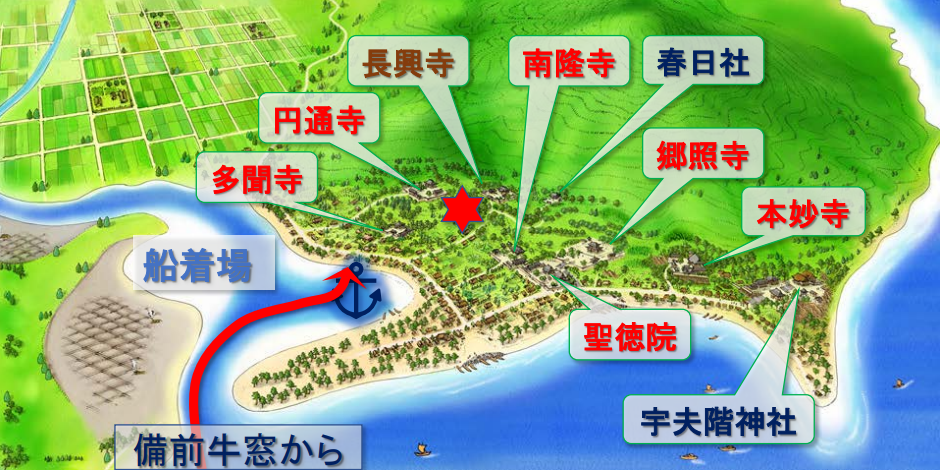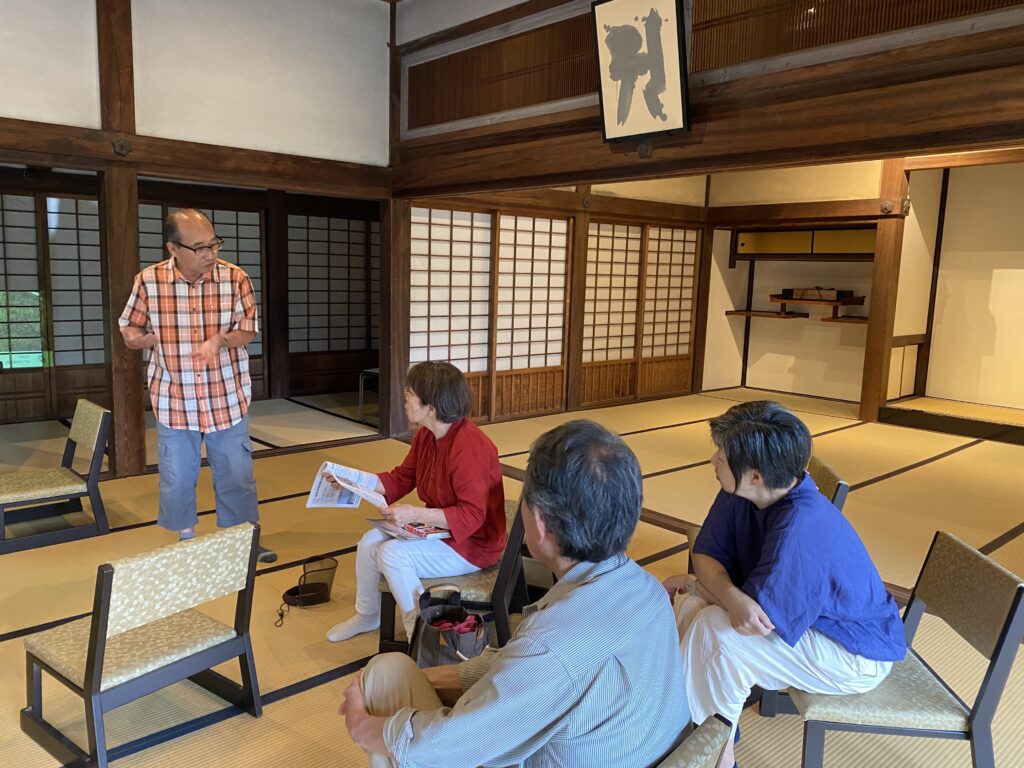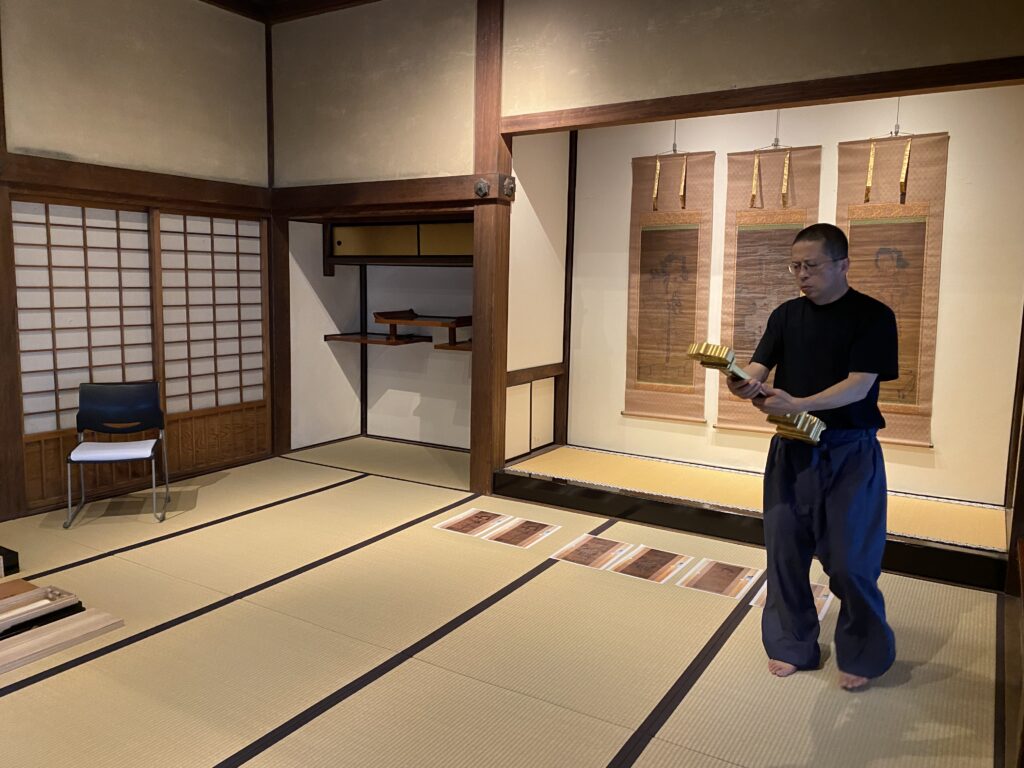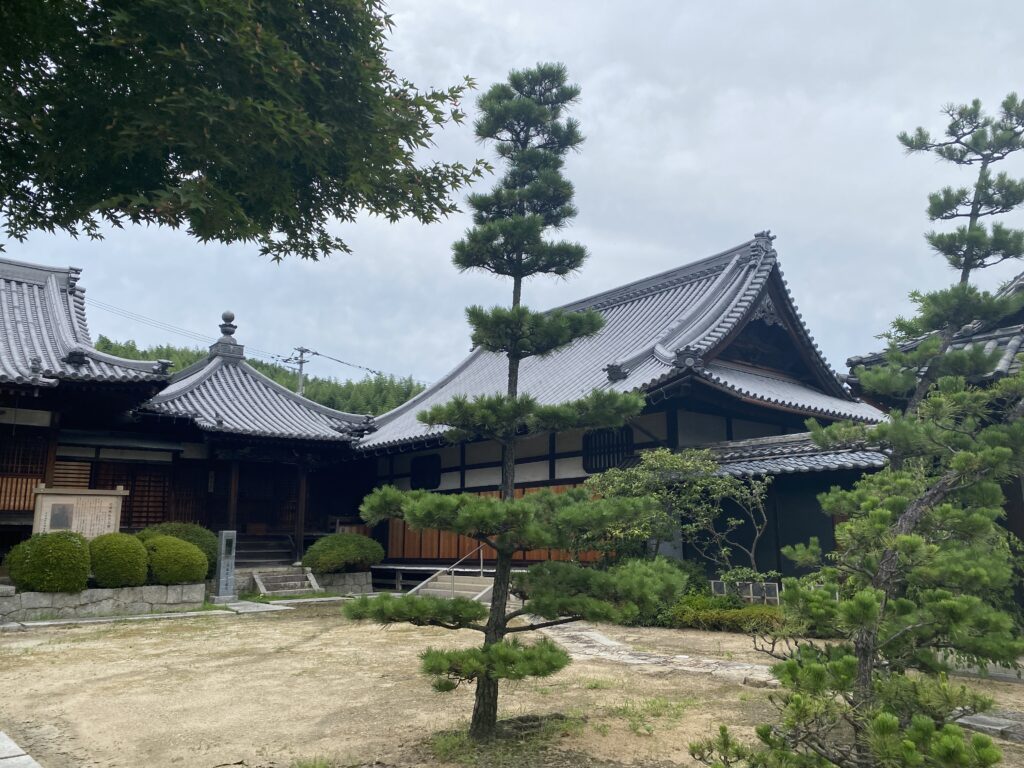前回の細川頼之と宇多津①では、
足利義満の側近として活躍していた、
細川頼之が宇多津に来た経緯についてご紹介しました。
続いては、宇多津で過ごした様子を、
今なお残る文献や文化財をもとに振り返っていきます。
In Part 1, we explored how Hosokawa Yoriyuki, the chief advisor to Ashikaga Yoshimitsu, came to Utazu following his political exile.
Now, we turn to his life in Utazu, as well as his long-awaited reunion with Yoshimitsu, drawing insights from historical records and cultural artifacts that still remain today.
義満との再会
畑さん
12年間、四国で寺社仏閣の整備をしたり、
国人を自分の部下にしたりとさまざまな事に取り組んだ頼之。
そんな中ついに、1389年に厳島詣の途中で宇多津に来た義満と再開します。
この時の様子は「鹿苑院殿厳嶋詣記」、「鹿苑院西国御下向記」に記載が残っています。

「海に開かれた都市」展図録(香川県歴史博物館)を基に作成。赤線が義満が入港してきたルート(推定)
義満は1389年3月6日に、宇多津に入港しました。
「鹿苑院殿厳嶋詣記」にはこのように記されています。
※鹿苑院殿厳嶋詣記 (宇多津文化財保護協会 畑 元 口語訳)
夜中前頃、沖にかがり火がちらほら
これがかの讃岐の「宇多津」である。
ほどなく御座舟は到着した。
Reuniting with Ashikaga Yoshimitsu
During his 12 years in Utazu, Yoriyuki engaged in various efforts, including the restoration of temples and shrines and consolidating local samurai clans under his command.
Finally, in 1389, while en route to Itsukushima Shrine, Ashikaga Yoshimitsu stopped in Utazu, where he reunited with Yoriyuki. This encounter is documented in historical texts such as “Rokuon’in-den Itsukushima Mode-ki” (鹿苑院殿厳嶋詣記) and “Rokuon’in Saigoku Gekō-ki” (鹿苑院西国御下向記).
Yoshimitsu’s Arrival in Utazu
On March 6, 1389, Ashikaga Yoshimitsu entered the port of Utazu. The scene is vividly described in Rokuon’in-den Itsukushima Mode-ki:
“Before midnight, faint bonfires flickered offshore.
This must be the port of Utazu in Sanuki Province.
Soon after, the lord’s vessel arrived.”
玉井さん
夜中でもかがり火が焚かれていたということは、
義満の来訪を、頼之は歓迎していたという事ですね。

畑さん
そうですね。
頼之が義満との再会を喜んだことは、
「鹿苑院殿厳嶋詣記」の3月7日の記述からも読み取ることができます。
※鹿苑院殿厳嶋詣記 (宇多津文化財保護協会 畑 元 口語訳)
海が北に広がり、渚に水夫らの家。
東は山の尾根が北の方に伸びている。
磯には松の古木等が枝を張っている。
~(中略)
頼之は宴会中、小躍りして有頂天。
酔ったように歩いて騒いでいる。
義満将軍への立派な献上物あり。
供の者への引出物も、太刀、鎧など見たこともないようなものばかり。
この文章の前半の景色は宇多津の青の山の方角を見て書いたものではないかと思います。
さらに、この「鹿苑院殿厳嶋詣記」の作者である今川了俊が、
この旅行記で詠んだ和歌には、ここ、圓通寺からみえる松山白峰※の情景が詠われています。
こうして宇多津にて義満との再開を果たした頼之は、この後京都へ戻ることになるのです。
※崇徳上皇陵墓がある場所
童銅さん
その頃の圓通寺は今よりも上の位置にあったので、
今より松山の景色が見やすかったかもしれないですね。
畑さん
このように文献から頼之と宇多津の関係が分かるのは興味深いですよね。
実は今話している圓通寺にも、頼之にまつわるものがあるんです。
A Warm Welcome in the Dead of Night
Tamai:
The fact that bonfires were lit at night suggests that Yoriyuki was anticipating and warmly welcoming Yoshimitsu’s arrival.
Hata:
Absolutely. Yoriyuki’s joy and excitement at this long-awaited reunion are also evident in the March 7 entry of the same document:
“To the north, the sea stretches wide, with fishermen’s homes along the shore.
To the east, mountain ridges extend northward.
On the rocky coast, ancient pines spread their branches.
(…)
During the banquet, Yoriyuki danced in joy, overcome with emotion.
He walked unsteadily, as if intoxicated, laughing and celebrating.
Grand tributes were presented to Lord Yoshimitsu,
and even the attendants received extravagant gifts—swords, armor, and other items never before seen.”
The landscape described here appears to depict Utazu’s Aonoyama hills.
Moreover, the travelogue’s author, Imagawa Ryōshun, composed a waka poem referencing Matsuyama Shiramine (the burial site of Emperor Sutoku)—a location visible from Entsū-ji Temple in Utazu.
After this joyful reunion, Yoriyuki returned to Kyoto, where he lived out his final years.
圓通寺に伝わる不動明王像
畑さん
圓通寺には「絹本墨画不動明王像二童子像」という香川県指定有形文化財があります。


これを描いたのは竜湫周沢(りゅうしゅうしゅうたく)という人物です。
彼は、各地に安国寺・
童銅さん
その竜湫周沢が描いた絵が圓通寺にあるということは、
細川頼之と圓通寺は非常に密接な関係にあったと言えますね。
瀧川さん
1300年代に描かれたものが圓通寺にある…。
長い歴史を感じますね。

畑さん
そうですね。
頼之がいた当時とは圓通寺の場所や建物が変わっていますが、
見える景色は変わりません。
お寺も古くからある街ということですね。
2029年には頼之生誕70年を迎えるので、
圓通寺で何か開催したいですね!
The Fudō Myōō Image at Entsū-ji
Entsū-ji is home to a Kagawa Prefecture-designated Important Cultural Property:
Silk Scroll of Fudō Myōō with Two Attendants (絹本墨画不動明王像二童子像)
This ink painting was created by Ryūshū Shūtaku (竜湫周沢), a disciple of Musō Soseki (夢窓疎石)—a renowned Zen master who promoted the construction of Ankoku-ji Temples and Rishō Stupas throughout Japan.
A Divided Brotherhood
While Ryūshū Shūtaku was a supporter of Yoriyuki, his fellow disciple, Shun’oku Myōha (春屋妙把), was involved in Yoriyuki’s exile.
Dōdō:
The fact that a painting by Ryūshū Shūtaku remains here at Entsū-ji reinforces the temple’s close connection to Yoriyuki.
Takigawa:
A piece of artwork from the 1300s still preserved here—it truly gives a sense of history.
A Timeless Landscape
Hata:
Although the original structures and exact location of Entsū-ji have changed since Yoriyuki’s time, the landscape remains the same. Utazu has always been a town deeply rooted in its historical heritage.
Looking Toward 2029: 700 Years Since Yoriyuki’s Birth
In 2029, we will mark the 700th anniversary of Hosokawa Yoriyuki’s birth. It would be wonderful to organi
細川頼之と宇多津① を読む。